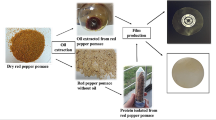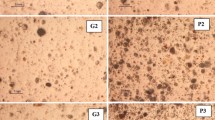Abstract
This study evaluated the quality of plums (Prunus domestica L.) coated with whey protein isolate (WPI) and WPI composite coatings containing 5 or 10% (w/w) flaxseed oil blended with beeswax. WPI and 10% lipid composite coatings were less susceptible to crack, flake, and blister defects during the 15 days storage at 5°C compared to the 5% lipid formulation. The firmness of plums, determined by the penetration force using a 10-mm probe, was not significantly affected by the coating types except for the WPI-coated samples, which showed a significantly higher penetration force because of the higher strength for WPI film. Mass loss of plums during storage was substantially reduced because of coating, especially when coatings of higher lipid content were used. This was consistent with the water permeability for the standalone films, which decreased considerably when flaxseed and beeswax were added. The incorporation of lipid phase to WPI also significantly weakened oxygen barrier and mechanical properties. Migration of plasticizer and lipid phase to the film surface was observed during water vapor permeability tests, especially when the films were exposed to elevated humidity conditions. Overall, sensory evaluation showed that the coated plums were more acceptable than the uncoated controls.









Similar content being viewed by others
References
ASTM (2002). D882-02 Standard test methods for tensile properties of thin plastic sheeting. In Annual book of ASTM Standards American Society for Testing and Materials. Philadelphia, PA: ASTM.
ASTM (2005a). D3985-05 Standard test method for oxygen gas transmission rate through plastic film and sheeting using a coulometric sensor. In Annual book of ASTM Standards American Society for Testing and Materials. Philadelphia, PA: ASTM.
ASTM (2005b). E96/E96M-05 Standard test methods for water vapor transmission of materials. In Annual book of ASTM Standards American Society for Testing and Materials. Philadelphia, PA: ASTM.
Banerjee, R., & Chen, H. (1995). Functional properties of edible films using whey protein concentrate. Journal of Dairy Science, 78, 1673–1683.
Cisneros-Zevallos, L., & Krochta, J. M. (2003). Whey protein coatings for fresh fruits and relative humidity. Journal of Food Science, 68(1), 176–181.
Gennadios, A. (Ed.) (2002). Protein-based films and coatings. Boca Raton, FL: CRC.
Han, C., Zhao, Y., Leonard, S. W., & Traber, M. G. (2004). Edible coatings to improve storability and enhance nutritional value of fresh and frozen strawberries (Fragaria ananassa) and raspberries (Rubus ideaus). Postharvest Biology and Technology, 33, 67–78.
Health Canada (2006). Transforming the food supply—Report of the trans fat task force submitted to the Minister of Health June 2006. Available at: http://www.hc-sc.gc.ca. Accessed 23 May 2007.
Khwaldia, K., Perez, C., Banon, S., Desobry, S., & Hardy, J. (2004). Milk proteins for edible films and coatings. Critical Reviews in Food Science and Nutrition, 44, 239–251.
Krochta, J. M. (2002). Proteins as raw materials for films and coatings: Definitions, current status and opportunity. In A. Gennadios (Ed.), Protein-based films and coatings (pp. 1–42). Boca Raton, FL: CRC.
Le Tien, C., Vachon, C., Mateescu, M. A., & Lacroix, M. (2001). Milk protein coatings prevent oxidative browning of apples and potatoes. Journal of Food Science, 66(4), 512–516.
Lee, S. Y., & Krochta, J. M. (2002). Accelerated shelf-life testing of whey-protein-coated peanuts analyzed by static headspace gas chromatography. Journal of Agricultural and Food Chemistry, 50, 2022–2028.
Lee, J. Y., Park, H. J., Lee, C. Y., & Choi, W. Y. (2003). Extending shelf-life of minimally processed apples with edible coatings and antibrowning agents. Lebensmitte—Wissenschaft und- Technologie, 36(3), 323–329.
Lundblad, R. L. (Ed.) (2005). Chemical reagents fr protein modification (3rd Ed.). Boca Raton, FL: CRC.
Martin-Diana, A. B., Rico, D., Frias, J., Mulcahy, J., Henehan, G. T. M., & Barry-Ryan, C. (2006). Whey permeate as a bio-preservative for shelf-life maintenance of fresh-cut vegetables. Innovative Food Science and Emerging Technologies, 7, 112–123.
McHugh, T. H. (2000). Protein–lipid interactions in edible films and coatings. Nahrung, 44(3), 148–151.
Mei, Y., & Zhao, Y. (2003). Barrier and mechanical properties of milk protein-based edible films containing nutraceuticals. Journal of Agricultural and Food Chemistry, 51, 1914–1918.
Miller, K., & Krochta, J. M. (1997). Oxygen and aroma barrier properties of edible films: A review. Trends in Food Science & Technology, 81, 228–237.
Min, S., Harris, L., & Krochta, J. M. (2005). Antimicrobial effects of lactoferrin, lysozyme, and the lactoperoxidase system and edible whey protein films incorporating the lactoperoxidase system against Salmonella enterica and Escherichia coli O157:H7. Journal of Food Science, 70, M332–M338.
Min, S., Harris, L. J., & Krochta, J. M. (2006). Inhibition of Salmonella enterica and Escherichia coli O157:H7 on roasted turkey by edible whey protein coatings incorporating the lactoperoxidase system. Journal of Food Protection, 69(4), 784–793.
Min, S., & Krochta, J. M. (2005). Inhibition of Penicillium commune by edible whey protein films incorporating lactoferrin, lactoferrin hydrolysate, and lactoperoxidase systems. Journal of Food Science, 70, M87–M94.
Moldao-Martins, M., Beirao-da-Costa, S. M., & Beirao-da-Costa, M. L. (2003). The effects of edible coatings on postharvest quality of the “Bravo de Esmolfe” apple. European Food Research and Technology, 217, 325–328.
Perez-Gago, M. B., & Krochta, J. M. (2001). Denaturation time and temperature effects on solubility, tensile properties, and oxygen permeability of whey protein edible films. Journal of Food Science, 66(5), 705–710.
Perez-Gago, M. B., Rojas, C., & Del Rio, M. A. (2003a). Effect of hydroxypropyl methylcellulose-lipid edible composite coatings on plum (cv. Autumn giant) quality during storage. Journal of Food Science, 68(3), 879–883.
Perez-Gago, M. B., Serra, M., Alonso, M., Mateos, M., & Del Rio, M. A. (2003b). Effect of solid content and lipid content of whey protein isolate-beeswax edible coatings on color change of fresh-cut apples. Journal of Food Science, 68(7), 2186–2191.
Seydim, A. C., & Sarikus, G. (2006). Antimicrobial activity of whey protein based edible films incorporated with oregano, rosemary and garlic essential oils. Food Research International, 39, 639–644.
Shaw, N. B., Monahan, F. J., O’Riordan, E. D., & O’Sullivan, M. (2002a). Effect of soya oil and glycerol on physical properties of composite WPI films. Journal of Food Engineering, 51, 299–304.
Shaw, N. B., Monahan, F. J., O’Riordan, E. D., & O’Sullivan, M. (2002b). Physical properties of WPI films plasticized with glycerol, xylitol, or sorbitol. Journal of Food Science, 67, 164–167.
Shellhammer, T. H., & Krochta, J. M. (1997). Whey protein emulsion film performance as affected by lipid type and amount. Journal of Food Science, 62(2), 390–394.
Shellhammer, T. H., Rumsey, T. R., & Krochta, J. M. (1997). Viscoelastic properties of edible lipids. Journal of Food Engineering, 33, 305–320.
Talens, P., & Krochta, J. M. (2005). Plasticizing effects of beeswax and carnauba wax on tensile and water vapor permeability properties of whey protein films. Journal of Food Science, 70(3), E239–E243.
Author information
Authors and Affiliations
Corresponding author
Rights and permissions
About this article
Cite this article
Reinoso, E., Mittal, G.S. & Lim, LT. Influence of Whey Protein Composite Coatings on Plum (Prunus Domestica L.) Fruit Quality. Food Bioprocess Technol 1, 314–325 (2008). https://doi.org/10.1007/s11947-007-0014-1
Received:
Accepted:
Published:
Issue Date:
DOI: https://doi.org/10.1007/s11947-007-0014-1




